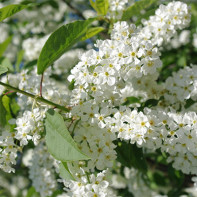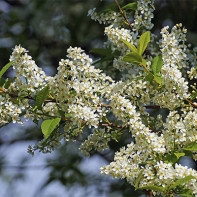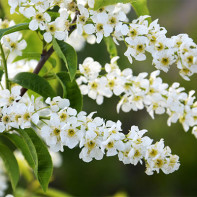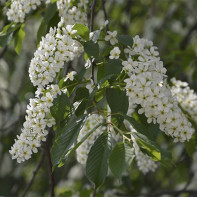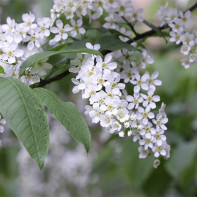Bird cherry: medicinal properties and contraindications
For a long time bird cherry has been a symbol of love, youth and purity. Its gentle pleasant aroma kept the innermost secrets of lovers and healed wounded souls.
- Chemical composition
- What does bird cherry look like and where does bird cherry grow
- Kinds
- Collection and storage
- The healing properties of bird cherry
- For women
- For men
- During pregnancy
- When breastfeeding
- For kids
- Bird cherry in traditional medicine
- Types of healing compounds
- Infusion
- Tincture
- Decoction
- Tea
- Ointment
- Application in cosmetology
- For healing acne and wounds
- Mask for rejuvenating and nourishing the skin
- Youth Lotion
- Bird cherry in cooking
- Kissel
- Kvass
- Solodiki with bird cherry
- Jam
- Drink (coffee)
- Cupcakes
- Buns
- Plain chocolate cake
- What is useful for bird cherry flour
- Contraindications
Legends telling about the appearance of bird cherry in our world are passed down from generation to generation. One of them says that one young girl fell in love with a young man who did not share her feelings. The girl suffered for a long time, her heart could not cope with it. In the end, the girl died, her heart became cold, and she turned into a beautiful tree. This explains the fact that during the cherry blossom, a sharp cooling usually occurs.
Among the ancient Slavs, this tree was considered the sacred patron of love, they guarded it and looked after it. There is a popular belief that the bird cherry got its name because of the color of the trunk: in the Old Slavic language there is the word “Cherma”, which means “dark-skinned”. The first records of this tree appeared in the 15th century.
Bird cherry (Padus) belongs to the family Rosaceae (Rosaceae), grows in Eurasia, South and North America. There are more than 20 species of this plant.
Chemical composition
The composition of the fruits of bird cherry contains glycans and tanning agents. They are also rich in essential oils, micro and macro elements, vitamins.
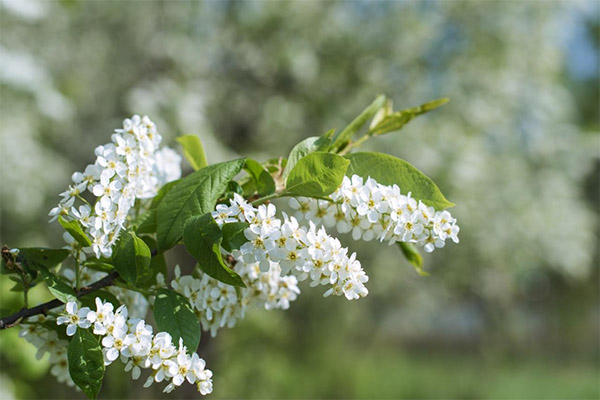
- Triacylglycerides are part of the bones. They also contain glycosides.
- Leaves contain vitamins and all the same essential oils.
- Bark, flowers, fruits include tanning agents and cyanide hydrocarbon (hydrocyanic acid), which is a toxic element.
- Almost all plants have benzoic aldehyde. It just determines the volatile properties of bird cherry.
The maximum amount of bioactive substances is in the fruit.
Vitamins (mg):
- C - 23.1;
- E - 3.67;
- PP (nicotinic acid) - 6.31.
Minerals (mg):
- calcium - 2.2;
- potassium - 13.4;
- magnesium is 1.2.
Trace elements (mg):
- cobalt - 7.0;
- copper - 22;
- iron - 0.04;
- Manganese - 1;
- zinc - 15.6.
What does bird cherry look like and where does bird cherry grow
Bird cherry is a tall bush or tree. Cherry with plum are also cultures of the Rosaceae family, so the plants are similar, especially during flowering. The height of the tree depends on the species and can range from 5 to 18 m. In the wild you can find bird cherry about 30 m high.
The bark of a young plant has a dark gray or brown color with white-yellow lentils. In adult plants, it is cracked and covered with brown spots. Inside, the bark is yellow with a pronounced minute smell.
The trunk is usually curved, in diameter it can reach 0.4 m.
The leaves are oblong or oval with a pointed apex. Leaf length - from 6 to 25 cm, width - 5–7 cm. Color depends on the age of the tree. In young plants, the leaves are golden green; in old plants, they are dull green. The underside of the sheet is matte, the top is shiny. By autumn, the foliage changes color to bright yellow or red.
The crown is thick, wide, with hanging or erect branches.
Flowers appear by the end of May and last until about 10 June. Depending on the species, they are red, pink or white, gathering in flowering inflorescences of about 12 cm long. Flowers, bark and leaves secrete volatile, disinfecting the air.
Bird cherry grows everywhere in our country in the middle latitudes, in the regions of the Far North is rare.It can be seen in all types of forests. The plant prefers the most illuminated places: clearings, edges, undergrowth. On the banks of water bodies it can form impenetrable thickets. Bird cherry is able to grow on any soil, but the strongest and most healthy plants develop on rich loamy soils with sufficient moisture. On swampy soils bird cherry does not grow.
Kinds
There are more than 20 types of bird cherry. Almost all species are tree-like or shrubby. Some varieties are decorative, others produce fruit. The most common in nature are the following species:
- Common (carpal).
- Late.
- Virgin.
- Maak.
- Pennsylvania
- Siori.
- Antipka.
- Magaleb.
- Self-fertile Sakhalin.
- Poskistnaya.
- Shallow-sawed amanogawa.
The bird cherry has two more names: bird and carpal. In natural nature, it grows in Eurasia. Usually it is a tree-like species, but shrubby is also rare. The tree grows up to 18 m. Green foliage with a blue tint. Blooms annually in late May. The fruits are dark, small in size, up to 5 mm across, slightly sweet. Bird cherry ordinary is divided into varieties. Among them you can find very interesting:
- Pendula is a falling crown.
- Pyramidalis is a pyramidal crown.
- Plena - terry flowers.
- Leucocarpa - fruits of a yellowish color.
- Aucubaefolia - leaves with small yellow spots.
For bird cherry trees, the regions of North America are the late native habitat. She also feels good in our country, settling in temperate latitudes. This is a strong self-fertile tree, the height of which reaches 30 m. The flowering is plentiful. In the fall, green-saturated leaves change their color to yellowish red. The bark of the tree has a black color, rather large fruits reach a diameter of 10 mm. These fruits are edible, slightly bitter, ripen in autumn. The plant has powerful roots. It tolerates winter frosts.
Virgin bird cherry is found in the nature of North America. The tree-like form can grow up to 15 m. Shrub representatives are medium-sized, up to 5 m, with white flowers, red-burgundy color of leaves. The flowering period - in the last days of May, is not accompanied by the smell of bird cherry, the flowers do not smell. The fruits are medium sized, reddish, edible. Low temperatures, heat and drought can not harm the plant, it is resistant to climate change. This type of bird cherry has several original varieties:
- Nana is a low shrub.
- Rubra - fruits of cherry color.
- Melanocapra - berries of black color.
- Xanthocapra is a slightly yellowish fruit.
- Pendula is a falling crown.
Maak grows in the natural environment in China and Korea, as well as in the south of the Far East. Trees of this species grow up to 17 m. Shrubs, from 4 to 8 m high, are rare. A cone-shaped crown adorns the plant. The bark is orange-red, smooth, without roughness, has the property of exfoliating. Saturated foliage greens turn yellow in the fall. White flowers are odorless. Fruits are not suitable for eating. Maak is resistant to winter frosts, grows rapidly, but without good lighting and plenty of moisture will not develop.
Pensilvan cherry is native to the natural territory of North America, but has adapted well to our climate. A plant of this species is an upright tree, the height from the ground to the crown crown reaches 12 m. There is also a shrub form, but it is quite rare in nature. The bark of a cherry-colored tree, luxurious crown has an oval shape. Green leaves turn bright red in the fall. White inflorescences are large in size. Small red berries appear only in the third year after planting. Bird cherry of this species blooms profusely, bears fruit generously. The dense branched root system allows the tree to easily endure any weather conditions, develop anywhere and on any soil.
Sori can be found in the natural environment of the Kuril Islands, Sakhalin and the northern regions of China. Bird cherry trees reach 10 m in height.At the very top of the crown, the foliage is green in color; towards the bottom, the color smoothly turns into lime. Young leaves and inflorescences are painted in the same color - red-lilac-lilac. A flowering tree spreads a very strong aroma around itself. Large-sized fruits, up to 12 mm across, are suitable for human consumption.
Antipka has only a shrubby form. She chose to grow the Far East and Europe. The root system of the plant is well developed, it easily adapts to various types of soil. Shrubs are often planted on slopes to prevent soil slipping. Still such bird cherry serves as a good stock for fruit bush plants. Inflorescences of a white color are small in size, have a pleasant gentle smell. Small fruits have a blackish tint.
Magalep bird cherry is widespread in Europe. Trees grow up to 10 m, and the crown reaches 8 m in width. Fragrant white flowers gather in a brush in the shape of a shield. Black fruits do not differ in large sizes, have a bitter aftertaste. The plant needs fertile soil, good light. It blooms and begins to bear fruit 3-4 years after planting. The tree tolerates high and low temperatures well. Often these plants are used as hedges. They live a long time, and pruning branches to shape the crown has a good effect on their development.
Samoplodnaya and Sakhalin - an early ripe plant. By mid-summer, the fruits are already ripening. They have excellent taste. The tree can reach a height of 8 m, resistant to adverse weather conditions. Self-made bird cherry has a high yield: one tree can produce about 20 kg of fruit.
Poisonous bird cherry grows well and develops in the northern and middle latitudes. The tree is relatively low, the maximum height is 5 m. The trunk is rough, gray, young branches are brown. Snow-white inflorescences collect 40 flowers each. Brown fruits have a yellow, very juicy pulp. Sweet and sour-tasting fruits have astringency. The tree is abundantly flowering and high-yielding, has good resistance to frost and pests. Fruits are eaten in any form: fresh, dried, canned.
The finely sawed Amanogawa is the most beautiful of all species. The plant has an interesting crown in the shape of a dome. Flowers of a beautiful pale pink color with terry. Abundantly blooming bird cherry is not only beautiful, but also exudes a pleasant delicate aroma.
Collection and storage
In early spring, when only nature comes to life from winter sleep, bird cherry picking begins. At the beginning of sap flow, bark and branches are harvested. They can be dried as a whole, but to speed up the process and ease of storage, thin branches and bark are chopped with a pruner or knife into small pieces. Then they are laid out on a flat surface under a canopy or in a well-ventilated room, you can send raw materials to a drying cabinet. After drying, everything is put into bags of cotton cloth and stored in a dry room for up to 5 years.
Flowers and leaves are harvested during the flowering period. Do not cut off all the inflorescences in a row. It is better to thin out, plucking them in different places, especially where they grow too densely. This will help the remaining inflorescences to receive more light, to develop better and to give more fruits in the future. Flowers and leaves are not chopped, dried or in the fresh air, or indoors, or in special drying chambers. Such blanks are stored in bags not so long as branches and bark. Use is limited to 1 year.
The collection of fruits is carried out at a time when they are fully ripe. Be sure to check that the fruit does not come across with damage. They do not need to be collected if the tree is sick or suffers an invasion of pests, even if the fruits themselves seem completely healthy. Bird cherry gathering is necessary for carrying out in cool dry weather. This can be done in the morning, after the dew has dried, or in the evening. The brushes are cut off entirely. Harvested fruits should never be exposed to moisture.Bird cherry brushes are laid out in a thin layer and dried in the same way as other parts of the plant. After drying, the fruits are cleaned of twigs and stalks, put in fabric bags. They can be stored for up to 2 years in rooms without access to moisture.
Some people think that fruits can be dried in the sun. This is a moot point, since all medicinal plants are not recommended to be exposed to sunlight during drying.
It must also be remembered that it is impossible to harvest any plants, including bird cherry, near roads and close to enterprises with harmful production. All plants, like a sponge, absorb the exhaust gases of cars, toxic industrial emissions.
The healing properties of bird cherry
The property of bird cherry to heal people from many diseases has been known for a very long time. This beauty has truly miraculous abilities. First of all, people realized that the astringent taste of berries suggests that they can be used as an astringent in various disorders of the gastrointestinal tract. In the process of application, it turned out that all parts of the plant to one degree or another have medicinal qualities: diuretic, anti-inflammatory, diaphoretic, and hemostatic.
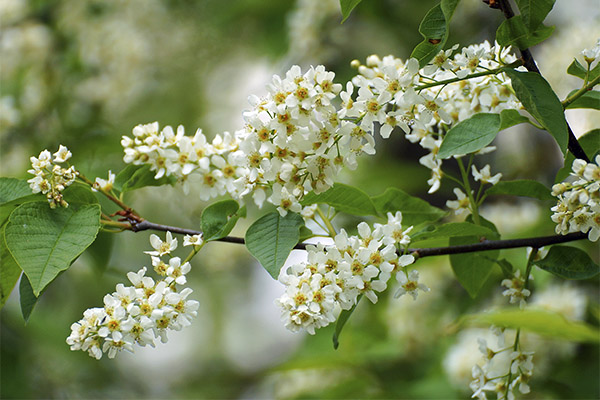
The largest amount of substances beneficial to the human body is found in fruits.
- A large amount of vitamin C determines the use of fresh fruits, or infusion of dried - with vitamin deficiency. In difficult military times and in long sea voyages bird cherry rescued people from scurvy. Vitamin C strengthens the immune system, regulates blood glucose, has anti-inflammatory effect, is a powerful antioxidant.
- Vitamin PP is involved in the formation of hormones. Niacin helps to maintain the normal nervous system, prevents the occurrence of migraine, facilitates its course.
- Vitamin E protects against cardiovascular disease. It is necessary for women during pregnancy. In the male body, it acts on sperm, increasing their motility. Vitamin E prevents the degeneration of the organs of vision, including cataracts.
A lot of berries and trace elements:
- Copper in the human body helps to absorb the gland, is involved in providing oxygen to tissues and the production of hemoglobin.
- Zinc increases the body's resistance to infections. It is necessary to maintain healthy teeth, promotes wound healing, relieves inflammation. Zinc is the main element in the structure of the eye, so its amount in the body affects vision.
- Cobalt helps the production of thyroid hormones, helps to remove cholesterol from the body, especially from blood vessels, preventing the formation of plaques. It also selectively prevents the division of cancer cells.
- Manganese contributes to the formation of bones, cartilage and connective tissue, therefore it is very important for a growing body. This trace element interferes with fatty liver hepatosis.
- Fruits fully possess all the properties that other parts of the plant have to varying degrees.
- The bark of the plant is used for the preparation of antipyretic, diuretic and diaphoretic agents. Decoctions are used in gynecology for inflammatory processes in the urogenital system of women.
- From the leaves make decoctions for gastric disorders and digestive disorders, not caused by infectious pathogens. It should be noted that the leaves are outsiders in terms of the amount of useful substances contained in them.
- The infusion of flowers helps with various kinds of inflammation of the eyes. It is most effective to distill the infusion through a distiller, then the maximum amount of medicinal components will be in distilled water, and the result of application will be noticeable much faster.
- Preparations from the bark and twigs will ease joint pain, relieve inflammation.
- Bird cherry helps to heal wounds, restores damaged skin.
- Bird cherry drinks relieve stress, provide a healthy sleep, increase the body's resistance to diseases, improve eyesight.
- With the help of funds from bird cherry get rid of intestinal parasites. The main thing is to be sure that the bull tapeworm did not settle there: it will not succeed in expelling it in this way, and it can cause great trouble to the body.
For women
Bird cherry preparations are useful for the female body. They increase immunity, help fight depression, improve skin color and hair condition. Decoctions and infusions of the cortex are used in gynecology for douching in inflammatory processes of the genitourinary system. Previously, bird cherry remedies were effectively used by women as a contraceptive. Now they are successfully replaced by chemicals.
For men
Remedies from bird cherry help men restore fertility, as they improve the composition of seminal fluid and increase sperm mobility. Bird cherry favorably affects the general condition of the body, strengthens the muscular system, improves blood circulation.
During pregnancy
During pregnancy, taking drugs from bird cherry is not recommended. This can adversely affect the development of the fetus.
When breastfeeding
A nursing mother should not use the means of cherry inward, because they are passed on to the baby with milk, and the dosage may be too large. With caution, you can apply them externally.
For kids
Bird cherry remedies are useful for a growing organism: they strengthen immunity, contribute to the normal growth and development of bone and muscle systems. However, children should use these drugs with great care, it is better to consult with a specialist first.
Everyone needs to remember that the bird cherry contains a component that is a potent poison - hydrocyanic acid (hydrogen cyanide). In scanty amounts, it is safe. For example, for poisoning to occur, you need to immediately eat 50 nucleoli from the seeds of cherry berries. Hydrogen cyanide is also found in the bones of other plants, but in smaller quantities. For example, in order to get poisoned with apricot kernels, you need to eat 100 of them. Hydrocyanic acid does not accumulate in the body, its molecules combine with glucose molecules and gradually leave the human body as a non-toxic substance. But the dosage of the funds from bird cherry taken orally should be strictly monitored, here more is not better.
Bird cherry in traditional medicine
In connection with the presence of hydrogen cyanide in bird cherry, official medicine is in no hurry to use its medicinal properties. In the pharmacy you can buy only dried berries and water from flowers, which is used to wash the sore eyes.
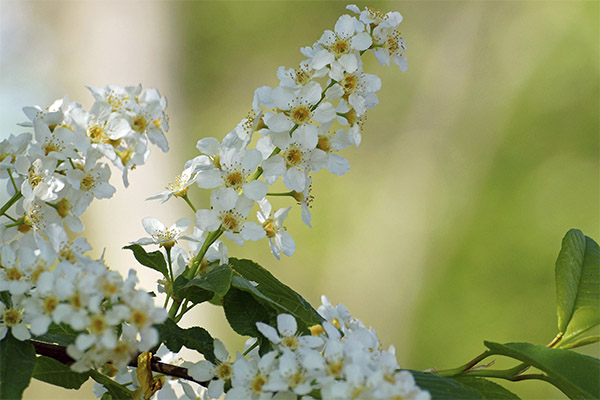
In folk medicine, bird cherry has been used for a long time and is widely used. For external use, it is absolutely safe.
- With radiculitis, rheumatism, arthritis and arthrosis, compresses from the extract of bird cherry help: 20 g of dried bark or twigs pour 500 ml of boiling water, cover, let cool to room temperature. Make compresses on the sore spot. To enhance the effect, you can cover the compress with cellophane and wrap a towel.
- It helps to cough with acute respiratory infections, bronchitis: pour 20 g of fresh leaves with 200 ml of boiling water, boil for 10 minutes over low heat under a lid. Allow to cool, strain, add boiled water to the original volume. Take 100 ml 3 times a day.
- Diaphoretic and diuretic: 5 g of dried, powdered bark, pour 1 cup boiling water, boil for 15 minutes. Set to cool, then strain and add water to 200 ml. Drink 1 teaspoon three times a day.
- It will help with colitis, enteritis: dry, grind, pour 200 g of fresh bark, pour 200 ml of boiling water, put on low heat and bring to a boil. Let it brew for 50-60 minutes. Take 1 tablespoon in the morning and evening.
- Relieve sore throat with angina: 1 teaspoon of dried berries pour 400 ml of boiling water. Let it brew for at least 8 hours. Gargle 3 times a day.
- It is used for furunculosis, dermatitis, ulcers: cut 20 g of fresh leaves and thin branches, pour 1 cup of boiling water. Insist 30 minutes, strain. Apply as lotions.
- Relieves oral inflammation: 1 tablespoon of dried berries pour 200 ml of boiling water. Simmer for 10 minutes. Insist at room temperature for 2 hours. Rinse the oral cavity 3 times a day.
- It normalizes the rhythm of the heart, calms the nervous system: pour 1 glass of fresh slightly mashed berries into 500 ml of vodka. Insist in a dark place for at least 3 weeks. Strain and refrigerate. Take 2 teaspoons in the morning and evening.
- It will help with joint and muscle pain: 2 tablespoons of chopped leaves and twigs pour 500 ml of boiling water. Simmer for 10 minutes over low heat, strain. Drink 50 ml 3 times a day.
Types of healing compounds
There are several types of healing compounds:
Infusion
Pour medicinal raw materials of one or several types with boiling water and insist for several hours, depending on the recipe, strain. For some types of infusions, additional heating in a water bath is required, then the infusion time can be reduced.
Tincture
Pour the raw materials with vodka or other alcohol-containing solution, insist for 2 weeks or more at room temperature, strain. Then remove the tincture in a cold and dark place.
Decoction
Pour medicinal raw materials with cold or hot water and cook over low heat for 5-10 minutes, insist and strain briefly.
Tea
Pour raw materials with boiling water (1 teaspoon in 1 cup of water) and insist for several minutes.
Ointment
Ointment is a mild form of medicine. At home, mix the therapeutic components with fat and warm in a water bath for several hours.
Application in cosmetology
Berries of bird cherry, as well as its bark, are widely used in cosmetology. Bird cherry is a part of many cosmetic preparations produced on an industrial scale. This raw material gives the preparations a calming effect on the skin, relieves swelling and redness, helps to heal minor injuries, regenerates and strengthens skin cells. Most often, fruits are used to make cosmetics, and bark and leaves are less commonly used. Extracts of berries and bark, produced by the cosmetology industry, can be used as an independent tool, added to creams and lotions to enhance their action. Due to the chemical composition, the components of cherry products penetrate deep into the layers of the skin, cleanse it at the cellular level, nourish.

- Masks from cherry raw materials well nourish the skin, moisturize and tone, prevent its aging.
- The infusion of cherry flowers has long been used to rinse hair after washing it. It strengthens hair, gives it shine, silkiness.
- Berry infusion is recommended for use as a daily rubbing lotion.
- Juice of fresh berries will help get rid of acne. They need to lubricate the problem areas.
For healing acne and wounds
In equal amounts - 1 tablespoon each - flowers, leaves, bird cherry bark, calendula flowers pour 1 liter of water. Bring to a boil over low heat, cool without removing the lid. Rinse wounds, make lotions.
Mask for rejuvenating and nourishing the skin
Make mashed potatoes from fresh berries of bird cherry: 1 teaspoon of mashed potatoes mixed with 1 teaspoon of heated honey, add a spoonful of kefir. To make the mask thicker, you can add a little rye flour. Apply to the skin 2 times a week for 20-30 minutes. Rinse with warm water, adding a little lemon juice to it.
Youth Lotion
2 tablespoons of flowers pour 200 ml of boiling water, insist 1 hour.Add 2 teaspoons of glycerin and honey, 100 ml of vodka. Wipe face and neck area daily.
Bird cherry in cooking
Fragrant bird cherry has found its application in cooking. Many people remember the taste of pies stuffed with fresh cherry berries that were baked in the village by a grandmother. They seemed a masterpiece of confectionery art. The smell of fresh pastries with the smell of bird cherry cannot be forgotten. Jam is made from the fruits of this plant, compotes and syrups are made for the winter. On hot days, kvass from bird cherry will quench your thirst, and a variety of pastries from bird cherry flour will satisfy the taste of any gourmet. Tinctures are made from berries and added to tea.
Kissel
200 g of cherry fruit pour 1 liter of water and boil for about 15 minutes. Strain, add 3 tablespoons of sugar into the broth, bring to a boil again and pour in a thin stream 2 tablespoons of starch diluted in water, stir constantly. When it boils, the jelly is ready. Put to cool. For a brighter taste, you can add half lemon juice or honey to starch.
Kvass
Mash 3 cups of fresh fruit, add 300 g of sugar and leave for 12 hours. Then mix, put 5 g of fresh yeast and pour 3 liters of water. After a day, strain and leave the kvass for two days to complete the fermentation process. Pour into storage containers and place in a cold place.
Solodiki with bird cherry
3 cups of fat sour cream, 3 eggs, 1.5 cups of sugar, mix 1.5 cups of bird cherry and wheat flour and beat with a blender. Bake pancakes, stack them on top of each other, each smearing with cherry syrup. Top with whipped mixture of 2 proteins and half a glass of sugar and bake in the oven for 10-15 minutes.
Jam
It’s very easy to make cherry jam. First, pass the berries through a meat grinder 2–4 times. Then add sugar, let stand for 20 minutes and simmer for about an hour. For 1 kg of bird cherry, take 1.2 kg of sugar.
Drink (coffee)
Grind the dried berries in a coffee grinder to a powder state. Then cook like regular ground coffee.
Cupcakes
Take 120 g of bird cherry flour, 200 g of wheat flour, 240 g of sugar, 240 g of sour cream, 4 eggs, 1 teaspoon of slaked soda, 0.5 teaspoon of salt. Mix everything well, put into molds, bake for 30–40 minutes at 200 ° C.
Buns
Pour 100 ml of mineral water into a bowl, pour 50 g of sugar and 1 teaspoon of baking powder, add 50 g of olive oil, stir well. Pour 150 g of wheat and bird cherry flour and 1 tablespoon of starch. Knead, shape rolls, bake at 180 ° C for 15–20 minutes. If desired, you can add dried fruits, candied fruits to the dough. Sprinkle the finished buns with powdered sugar.
Plain chocolate cake
Mix 200 g of sugar, 250 ml of water, 100 ml of sunflower oil. Add 2 tablespoons of bird cherry flour and cocoa, 6 tablespoons with top of wheat flour, 2 teaspoons of baking powder, mix thoroughly, with a mixer, to make the dough uniform, without lumps. Bake in a greased form for 40–45 minutes at 180 ° C. After cooling, cut the cake into two parts, grease the bottom with cherry jam, put the second part on it, sprinkle with icing sugar.
What is useful for bird cherry flour
The drying process is a good method of preparation, as the composition remains as close as possible to the composition of the fresh product. With any heat treatment, the addition of preservatives, the content of nutrients is reduced.
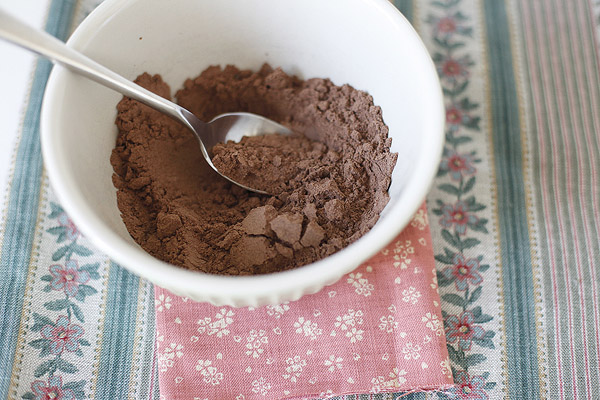
Flour from dried berries retains all the beneficial properties of bird cherry. Therefore, decoctions, infusions, and ointments are prepared from the powder: they will also cure ailments and can be used for cosmetic purposes.
Bird cherry is distributed almost throughout the territory of our country, however, flour is popular only in Buryatia and in Siberia. There it is produced industrially, but in small quantities. You can make flour yourself. To do this, you need to collect, properly dry the berries of the bird cherry and grind them in a coffee grinder.
The energy value of bird cherry flour is almost 3.5 times less than the calorie content of wheat flour.This is especially important for those who like cakes and pies, but do not want to gain extra pounds. If you cook only baked goods from bird cherry flour, nothing will work. Wheat flour is needed, and its share in the total mass should be at least 50%. Outwardly, cherry blossom flour resembles cocoa; it smells like almonds. The smell contains notes of vanilla and chocolate.
Contraindications
Bird cherry is a very useful plant. However, not everyone can take it as a medicine and eat it.
Bird cherry is contraindicated:
- people with chronic constipation and colitis;
- hemorrhoid patients;
- pregnant and lactating mothers;
- children under 3 years old;
- people with individual intolerance;
- suffering from hypotension.
Bird cherry is an amazing plant. In addition to its beauty, which people admire, it cures diseases, boosts immunity, preserves beauty and youth, makes dishes more healthy and varied, and helps fight harmful insects.
«Important: all information on the site is provided exclusively in fact-finding purposes. Before applying any recommendations, consult with a profile specialist. Neither the editors nor the authors are liable for any possible harm caused materials. "

